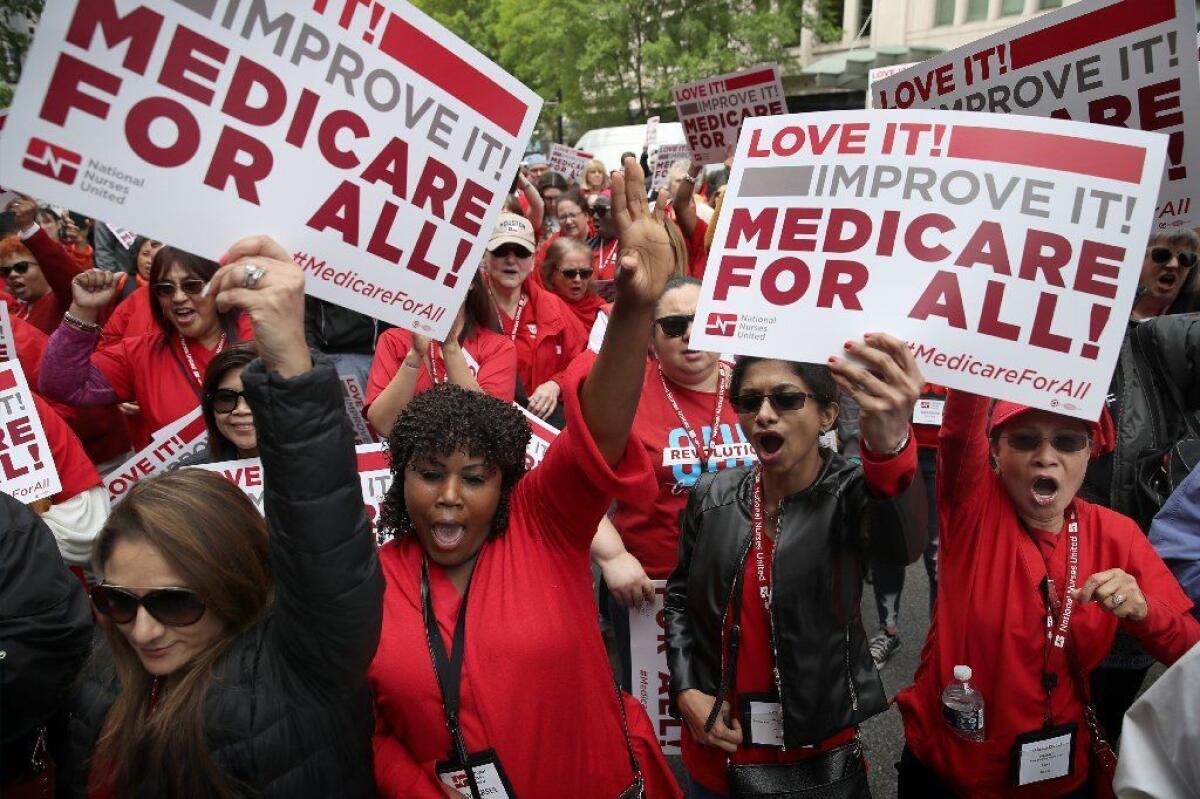Opinion: If Democrats want universal coverage, they need to abandon the ‘Medicare for all’ fantasy

Sen. Bernie Sanders’ once-quixotic campaign to abolish private health insurance in the U.S. — most of it employer-sponsored — in the name of “Medicare for all” has now become the leading progressive litmus test for anyone seeking the Democratic Party’s presidential nomination. Twelve of the remaining candidates subscribe to it, in various versions.
Unfortunately, the progressives’ eagerness to upend the entire $3.5-trillion U.S. healthcare system while canceling the current health insurance of 217 million Americans is based on some serious misconceptions.
It disregards what other countries actually do to achieve near-universal access to healthcare; it underestimates the financial consequences for Americans of such radical restructuring; and it fails to recognize how much easier it would be to achieve the same — or better — healthcare outcomes by building on, rather than dismantling, the Affordable Care Act.
While Sanders is correct that most advanced countries guarantee healthcare access to nearly all their residents, they do not necessarily do this through a single-payer national program like Medicare.
Most notably, some of the richest northern European countries like the Netherlands, Switzerland and Germany have what might be called “HealthCare.gov for all,” the central feature of the Affordable Care Act. They deliver access to healthcare by mandating that all households purchase private or nonprofit (not governmental) insurance policies, and subsidize the cost based on income — an approach identical to what the ACA offers Americans who buy policies through online insurance exchanges.
Canada has what might be called Medicaid for all, provincial programs that vary in terms of benefits offered. Provinces are reimbursed by the national government based on levels of provincial need and resources, much like our states are with respect to Medicaid. This approach is embodied in the Affordable Care Act’s Medicaid expansion program that — in the 36 states that implemented it -- made millions of Americans newly eligible for Medicaid by allowing people with higher incomes to qualify.
England has the equivalent of the U.S. Veterans Affairs healthcare program “for all,” with hospitals and healthcare providers directly supported by the national government.
Further, every country so admired by the Democratic progressives guaranteeing universal access to healthcare also has a large role for private insurance. In Canada, two-thirds of all households buy complementary private insurance to cover additional benefits and better care (much of it delivered across the border in the U.S.), as do almost 50% of Australians and 40% of Danish households, according to a May 2017 report by the Commonwealth Fund. In Germany, more than 10% of households opt out of the government program altogether and purchase unsubsidized private insurance. (In fact, most Americans on Medicare have supplemental coverage to fill Medicare gaps.)
The financial underpinnings of Medicare for all rest on the assumption that great savings will be achieved by abolishing the profits and administrative costs of the private insurance industry and that its total cost will be less (or at least not more) than current combined public and private expenditures. Additionally, some advocates claim that any increased taxes required will be offset by savings in out-of-pocket healthcare expenditures and health insurance premiums.
Each assumption is unfounded.
In 2017, according to the Centers for Medicare and Medicaid Services, the cost of administration and profit per privately insured individual ($618) was actually less than what government insurance programs (Medicare, Medicaid, VA and the Children’s Health Insurance Program) spent on administration alone ($921).
Even Sanders acknowledges that the cost of Medicare for all will be staggering. The Urban Institute, a policy research organization, estimates that the approach would add $2.54 trillion annually to the federal budget. Even if that were entirely offset by eliminating expenditures on private insurance (currently $1.68 trillion), that leaves $860 billion per year to be shouldered by federal taxpayers. Completely eliminating associated out-of-pocket costs (currently about $170 billion) would still require taxpayers to pay $690 billion.
What is most surprising about the Democrats’ advocacy of Medicare for all is their rejection of the Affordable Care Act as a far more realistic foundation for assuring universal access to healthcare.
Not only does the ACA incorporate elements of other countries’ approaches to universal healthcare coverage, it has provided health insurance to 20 million more Americans, cutting the uninsured rate by over 40%, according to a recent study by the Kaiser Family Foundation.
The ACA has also protected millions with preexisting health conditions from losing coverage, enabled young adults to be covered by their parents’ insurance, and made the scope of benefits more comprehensive and consistent for most Americans. And — in a feature that even the Trump administration supports — it has enabled states to test ways to use their Medicaid grant allocations to deliver more effective healthcare.
Unless it is overturned by a pending court challenge, the ACA is still the law of the land and can be strengthened to close the coverage gap both by executive order (undoing recent actions to weaken it) and a few reasonable amendments.
First, restore enforcement of the requirement that all Americans have health insurance and reinstate the subsidies that enabled uninsured middle-income individuals to afford private insurance offered on federal and state online insurance exchanges. More than 14 million more Americans can gain coverage this way and it would have the additional benefit of broadening the insurance risk pool, lowering the cost of insurance premiums for everyone.
Second, improve incentives to get the 14 states that declined to join the Medicaid expansion program to opt in. This would immediately insure an additional 2.5 million Americans.
Finally, to get to universal coverage, make a low-cost public health insurance option (as advocated by former Vice President Joe Biden) available for the 10 million Americans who can’t afford even subsidized private policies, but have incomes too high to qualify for Medicaid.
These fixes together would cost an estimated $200 billion annually, much of it in foregone taxes.
All Americans deserve access to healthcare equal or superior to that of other advanced nations. However, this does not require massively disrupting an industry that accounts for one-fifth of the U.S. economy, or legislation that has no realistic chance of passage, or a wildly extravagant increase in the federal budget.
The ACA has already moved the U.S. a long way toward universal access. Building on it with some eminently feasible reforms can finish the job.
Peter D. Salins is a professor of political science at Stony Brook University.
More to Read
A cure for the common opinion
Get thought-provoking perspectives with our weekly newsletter.
You may occasionally receive promotional content from the Los Angeles Times.






